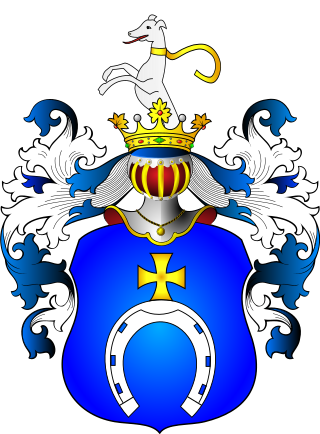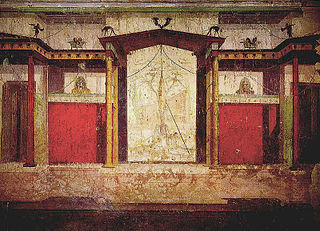A palatine or palatinus is a high-level official attached to imperial or royal courts in Europe since Roman times. The term palatinus was first used in Ancient Rome for chamberlains of the Emperor due to their association with the Palatine Hill. The imperial palace guard, after the rise of Constantine I, were also called the Scholae Palatinae for the same reason. In the Early Middle Ages the title became attached to courts beyond the imperial one; one of the highest level of officials in the papal administration were called the judices palatini. Later the Merovingian and Carolingian dynasties had counts palatine, as did the Holy Roman Empire. Related titles were used in Hungary, Poland, Lithuania, the German Empire, and the County of Burgundy, while England, Ireland, and parts of British North America referred to rulers of counties palatine as palatines.
A count palatine, also count of the palace or palsgrave, was originally an official attached to a royal or imperial palace or household and later a nobleman of a rank above that of an ordinary count. The title originated in the Late Roman Empire. In the Middle Ages especially and into modern times, it is associated with the Holy Roman Empire, especially Electoral Palatinate.

The prime minister of Hungary is the head of government of Hungary. The prime minister and the Cabinet are collectively accountable for their policies and actions to the Parliament, to their political party and ultimately to the electorate. The current holder of the office is Viktor Orbán, leader of the Fidesz – Hungarian Civic Alliance, who has served since 29 May 2010.

The Palatine of Hungary was the highest-ranking office in the Kingdom of Hungary from the beginning of the 11th century to 1848. Initially, Palatines were representatives of the monarchs, later the vice-regent (viceroy). In the early centuries of the kingdom, they were appointed by the king, and later were elected by the Diet of the Kingdom of Hungary. A Palatine's jurisdiction included only Hungary proper, in the Kingdom of Croatia until 1918 the ban held similar function as the highest office in the Kingdom, monarch's representative, commander of the royal army and viceroy.

Pobóg is a Polish coat of arms that was used by many noble families in medieval Poland and later under the Polish–Lithuanian Commonwealth.

Margaret Island is a 2.5 km (1.6 mi) long island, 500 m (550 yd) wide, in the middle of the Danube in central Budapest, Hungary. The island is mostly covered by landscape parks, and is a popular recreational area. Its medieval ruins are reminders of its importance in the Middle Ages as a religious centre. The island spans the area between the Margaret Bridge (south) and the Árpád Bridge (north). Before the 14th century the island was called Insula leporum. Administratively Margaret Island used to belong to the 13th district, but now is directly under the control of the city.
Palatinus, Latin for "palatial", were designations for various ecclesiastical offices in the Catholic Church, primarily of certain high officials in the papal court.

Mužlja is a neighborhood of the Zrenjanin city in Serbia. Formerly, it had been a separate village that joined with Zrenjanin in 1981.

Helena of Serbia was Queen of Hungary as the wife of King Béla II. After her husband's death, she governed Hungary as regent from 1141 to September 1146 together with her brother, Beloš, during the minority of her eldest son, Géza II, came of age.

The Paladins, also called the Twelve Peers, are twelve legendary knights, the foremost members of Charlemagne's court in the 8th century. They first appear in the medieval chanson de geste cycle of the Matter of France, where they play a similar role to the Knights of the Round Table in Arthurian romance. In these romantic portrayals, the chivalric paladins represent Christianity against a Saracen (Muslim) invasion of Europe. The names of the paladins vary between sources, but there are always twelve of them led by Roland. The paladins' most influential appearance is in The Song of Roland, written between 1050 and 1115, which narrates the heroic death of Roland at the Battle of Roncevaux Pass.
A palatine was a high-level official attached to imperial or royal courts in Europe since Roman times.

The House of Augustus, or the Domus Augusti, is situated on the Palatine Hill in Rome, Italy. This house has been identified as the primary place of residence for the emperor Augustus.
Uroš I was the Grand Prince of the Grand Principality of Serbia from about 1112 to 1145.

Lajos Méhelÿ was a Hungarian zoologist, herpetologist, professor, and author. He remains controversial due to his Social Darwinist and racialist publications. He was a member of the Hungarian Academy of Sciences, but renounced his membership.
Julius (I) from the kindred Kán was a powerful Hungarian baron and landowner, who held several secular positions during the reign of kings Emeric, Ladislaus III and Andrew II. He was the ancestor of the gens Kán which originated from Baranya County.
Rodowan was a nobleman who served Solomon, the King of Hungary, as palatine, the highest court title, around 1067.

Edina Szvoren is a Hungarian writer. She was born in Budapest and studied music at the Béla Bartók Music High School and the Franz Liszt Academy of Music.
The 1929 Greyhound Derby Final took place on 25 July 1929 at White City Stadium. The winner Mick the Miller received a first prize of £700 in a final with only four runners.
Erzsebet Palatinus is a Yugoslav table tennis player of Hungarian descent who competed in the 1979 World Table Tennis Championships in Pyongyang, where she won the bronze medal in women's doubles, together with Gordana Perkučin.
Benedict was a Hungarian lord at the turn of the 12th and 13th centuries, who served as Ban of Slavonia from 1199 to 1200 and as Palatine of Hungary from 1202 to 1204. He was a staunch supporter of Emeric, King of Hungary.










